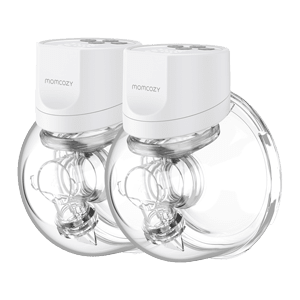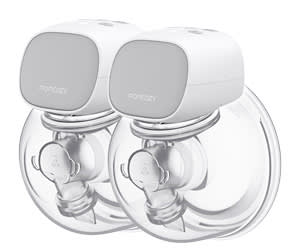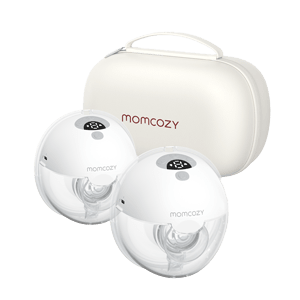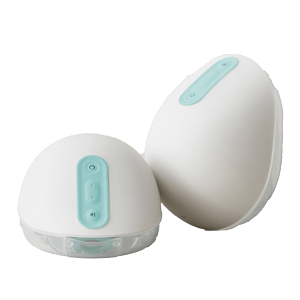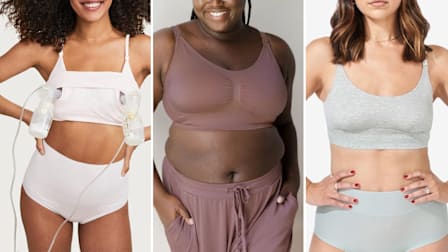Best Wearable Breast Pumps of 2025
Which wearable breast pump is the most comfortable or easiest to use? We asked 41 breastfeeding parents to share their experience using pumps from Momcozy, Willow, Elvie, and Lansinoh.
When you shop through retailer links on our site, we may earn affiliate commissions. 100% of the fees we collect are used to support our nonprofit mission. Learn more.

Wearable breast pumps promise more freedom of movement compared with traditional breast pumps. Battery-operated, wireless, and hands-free, wearable breast pumps sit inside a bra or nursing bra to attach securely to your breasts and extract milk while you work, grocery shop, drive older children to and from school or practice, and engage in other activities you can’t feasibly manage while breastfeeding, manually pumping, or using a wired pump.
The 2025 State of Breastfeeding survey from Mamava and Medela found that 81 percent of parents surveyed have pumped or nursed in their car—proving that on-the-go options are a necessity for many families.
- How We Evaluated Wearable Breast Pumps
- Best Wearable Breast Pumps: Momcozy S12 Pro Wearable Breast Pump Momcozy M9 Mobile Flow Hands-Free Breast Pump Elvie Pump Momcozy S9 Pro Wearable Breast Pump Momcozy All-in-One M5 Wearable Breast Pump Lansinoh DiscreetDuo Wearable Pump Willow Go Wearable Breast Pump Willow 360 Wearable Breast Pump
- FAQs About Wearable Breast Pumps
How We Evaluated Wearable Breast Pumps
Dana Keester and Kathy Trieu of CR’s consumer experience and usability research team recruited 41 women using some of the most popular wearable breast pumps on the market, including:
- Elvie Pump
- Momcozy All-in-One M5 Wearable Breast Pump
- Momcozy S12 Pro Wearable Breast Pump
- Willow 360 Wearable Breast Pump
- Willow Go Wearable Breast Pump
- Momcozy S9 Pro Wearable Breast Pump
- Momcozy M9 Mobile Flow Hands-Free Breast Pump
- Lansinoh DiscreetDuo Wearable Pump
All participants were lactating at the time and were active users of one of the eight wearable breast pumps we evaluated in this remote user study. We recruited five to six users for each pump, and gathered both qualitative and quantitative feedback based on the following criteria:
- Setup. Our respondents looked at the ease of assembling the pump for use and taking it apart for cleaning.
- Fit and comfort. We asked participants about the ease of positioning and removing the pump, and how comfortable it was to use.
- Operation. We asked users how satisfied they were with the location of buttons; the various modes, phases, and speed levels; and how simple it was to transfer breastmilk into another container.
- Cleaning. Users shared how involved or easy it was to clean the pump after using it.
- Noise. We asked participants how they felt about the motor sound when the pump was in use, and whether it was distracting or disruptive.
- Battery life and charging. We asked users how long the battery lasted and how many pumping sessions they could get on a single charge, as well as whether the pump recharged quickly.
Each study participant resided in the U.S. and owned a hands-free wearable pump that they had purchased new within the previous two years. They used their pump at least every few days within the previous two weeks of the study.
The Best Wearable Breast Pumps From CR’s Evaluations
Our top three wearable breast pumps all scored high marks for setup, operation, and noise, but you won’t find a wearable breast pump on this list that boasts a perfect score. Many of the pumps could have better battery life and charging capabilities, for example, and most could use improvements in fit and comfort, according to our users. But the best part of all? The top-scoring wearable pump is also the one that ranked as easiest to clean. See our full ratings below.
Shop: Amazon, Momcozy, Target, Walmart
Snagging the highest-ranked spot on our list is the Momcozy S12 Pro Wearable Breast Pump, which earned perfect scores in setup, cleaning, and noise. This model can be purchased as a double pump, $140, or a single pump, $75. (While the cost is reduced when you purchase one pump, it will increase the time that it takes to pump because each side will have to be pumped separately, according to Trieu.) The pump comes with 24-millimeter flanges (also known as “breast shields”—the piece that sits directly over your nipple to form a shield), but you can purchase a four-pack of smaller flange inserts (a soft silicone piece inserted into the flange for a more comfortable fit) on Momcozy’s website if the fit isn’t quite right. A helpful flange size ruler is also included (and is available on the Momcozy website) and allows you to measure your nipple size for the recommended flange fit, plus there’s some additional fitting guidance in the pump’s manual. “I got the perfect size flanges and that helps me wear it comfortably,” a 29-year-old Momcozy S12 Pro user from Texas said. “Other than that, I didn’t have to do anything special. Once you turn on the suction, it kind of just sucks your nipple right in.”
One standout feature about the Momcozy S12 Pro pump is that it’s the only model on this list that is double-sealed, which helps prevent leakage and improves pumping, according to the manufacturer—though all the models were reported to have leaked in some way, according to our participants. This pump features three modes (stimulation, expression, and mixed) and nine suction levels. While using it, your breast milk is pumped directly into an included 6-ounce milk collector, which participants said they then transfer into the milk storage item of their choice. A 33-year-old Momcozy S12 user from South Carolina said it’s easy to transfer expressed milk into a storage container as long as everything is aligned: “You can find out pretty quickly if it’s not aligned because the cups will begin to leak during the process.” This user was referring to the correct assembly of the pump and its parts when speaking of alignment, according to Trieu.
This Momcozy model also features a memory function that recalls your last-used settings. LED displays on the control panel show the running time of the pump in minutes, battery life, suction level, and mode. Participants were generally satisfied with the control features, such as speed levels offered, but a Momcozy S12 Pro user said: “For larger-chested people, the pump sits lower in the bra, making it difficult to reach the buttons easily.” In this case, using a pump with a connected app that allows you to change settings remotely might be more convenient. The Momcozy M9 or Willow pumps could be good options.
This pump ranked as the easiest to clean among all the pumps we assessed, though the pump’s parts do need to be hand-washed. Some participants said they spent the most time sanitizing the rubbery lips on the outer parts of the pump with a bottle brush (not included). As far as battery life and charging capabilities go, most participants were satisfied with how the pump could last at least a few pumping sessions, though some wished the battery lasted longer. According to the manufacturer, this pump has a charge time of 130 minutes and a usage time of 240 minutes (which translates to seven to eight 30- to 35-minute pumping sessions). It features a battery life indicator on its LED control panel with a 1-to-4 bar (4 indicates a full charge). The pump automatically shuts off after 30 minutes, and the device is covered under a one-year warranty for the U.S. and countries outside of the European Union, and a two-year warranty for EU countries.
Shop: Amazon, Momcozy, Target, Walmart, Babylist
Our participants liked the Momcozy M9 model for its high suction strength, consistent milk output, convenient app, and relatively gentle learning curve: Once settings were established, users described the pump as easy to use. The M9 pump features three regular modes: stimulation, expression, and mixed, as well as a custom mode and two others available through the connected app: Milk Boost and Milk Relief.
Convenience was frequently mentioned: Participants reported using the pump in a range of environments, including at work, while driving, during errands, and while performing housework. “I use it while driving most of the time. I’ve even pumped while at the dentist’s office,” said one 39-year-old user based in Maryland. While the general consensus was that most of the time, the pump peeks out from the top of a shirt, the pump’s performance outweighs this minor flaw. “It personally does not matter to me if my pump shows. It’s doing a job and I’m just glad I have it,” said one 32-year-old user in Texas. Noise could be a factor if discretion while pumping is important. The manufacturer’s website lists the M9 motor noise during pumping at under 42 decibels. “The noise level is not bad at home. I notice it more when everything is silent, but otherwise, it doesn’t bother me,” said a user in Georgia, age 33. But if you’re pumping on a Zoom call or during an in-person meeting, it could be more noticeable.
The M9 is currently the only Momcozy pump with a connected app: While you can change the pumping modes on the device itself, most users shared that they opted to control the pump speed and mode level through the app, “which is absolutely amazing,” said a 39-year-old user based in Maryland. “You can control everything right there. It’s very, very user-friendly, and that was another reason I did choose this pump because it is so user-friendly.” Other participants liked how the pump would remember your previous settings, so “once you set it, you can forget it.” And the battery life was good, too: Participants reported that a full charge lasted four to six pumps.
Though users found the pump easy to put together, participants struggled with ease-of-use issues in the early stages of pumping with the M9 that led to some leaking. However, most said that those issues improved over time.
The milk transfer process could be more convenient: The M9 comes with extra collection cups and caps, so you can store them directly without pouring milk into a separate container, but others noted that the lack of a spout on the cup made the process of pouring milk into storage bags a little messy. “I think if they made it like a water pitcher . . . that might lessen the spillage,” said the Maryland user.
Overall, the pump was rated as easy to clean, though some of the smaller parts, like valves, took extra time and care.
Shop single version: Amazon, Elvie, Target, Walmart
Shop double version: Amazon, Elvie, Target, Walmart
The Elvie Pump is one of the quietest wearable breast pumps on the market, the company says. The Elvie comes with two breast shield sizes, in 24 and 28 millimeters (you can purchase other flange inserts through Elvie’s website if needed), as well as two storage lids that can be used to seal the two included, reusable 5-ounce bottles after pumping directly into them. Users can choose to store milk in the included bottles or transfer milk to storage items of their choice. “When I transfer the milk, I am careful to pull off the valve and use the spoutlike shape to just pour the milk into either a bottle or bag depending on when I plan on using the milk,” a 37-year-old Elvie Pump user from New York said. “If all the milk doesn’t come out, then I unscrew the top and pour the remaining little bit out. I like to make sure to get it all because every last drop counts!”
The Elvie Pump is available for purchase as a double, $550, or single, $300, pump and has several “SmartRhythm” pumping modes (from gentle stimulation to expression) and various intensity settings. Some other unique features include two bra adjusters that can help add more room in bras for an optimal fit, and the pump connects to a mobile app that can be used to monitor milk output and control and track pumping sessions. Participants thought assembling and disassembling the model was easy overall and that the control buttons were convenient to access. Although all washable parts are dishwasher-safe, cleaning the pump’s valve, seal, and small crevices didn’t prove as breezy for participants (using a cleaning tool like a bottle brush, which is not included, for those areas can help, according to a few participants).
This model doesn’t come with a flange ruler, though some sizing guidance is included in the manual and on the manufacturer’s blog. It lacks an auto shutoff feature but has a timer function available through its app that allows you to set how long you want the pump to run before it turns off. Similar to the Momcozy S12 Pro, battery life and charging could be improved: It was overall favorable but did not stand out to participants, according to Trieu, who added that reported battery life varies, with some participants mentioning it lasts for a few hours to a few days, depending on the amount of usage and intensity. Elvie’s manufacturer claims its rechargeable battery lasts for five to six pumping sessions and takes 2 hours to charge. At the top of the pump, a battery indicator glows in red, orange, or green light to let users know how much battery power is left. Elvie offers a two-year warranty for the pump and a 90-day warranty for its parts. The company that makes the Elvie is now owned by the company that makes the Willow, another popular wearable breast pump.
Shop: Amazon, Momcozy, Target, Walmart, Babylist
Participants found the S9 Pro Wearable Breast Pump from Momcozy comfortable and convenient, though it wasn’t as quiet or easily concealed as participants would have liked. The S9 Pro is sold as a single or double pump set, and for some, it was one of the only wearable options available through their insurance plan. The S9 scored high marks in fit and comfort, and participants reported that they get a lot of use out of this pump: “I wear ’em everywhere,” said one 29-year-old user in South Carolina.
Users were generally impressed with the battery life, which, depending on the number of pumping sessions, could last all day or even several days. “The motors will stay charged through all my pumps,” said one user. The company’s website says it should last for eight or nine pumping sessions, and features an auto-shutoff after 30 minutes to help conserve power.
The Momcozy S9 Pro features two pumping modes (expression and mixed), each with nine suction levels, and comes with some of the largest pumping containers we’ve seen in a wearable pump: 6 ounces each, though the company says to keep pumping output around 4 ounces for best results. The pump’s LED screen lets you check suction levels, even in the dark, and users found the controls easy to access. While some found this pump a bit louder than expected, none said it was disruptive or problematic.
The S9 Pro comes with flanges in multiple sizes made from plastic and food-grade silicone, with additional sizes available to order from the manufacturer if needed. Users described the cleaning process as not difficult but somewhat tedious, given the number of parts involved.
CR’s testing team found the milk transfer process for this pump somewhat counterintuitive: It wasn’t easy to tell how to pour the pumped milk, given the round shape. “Pouring it into just like a traditional bag is a little bit tricky. I have to be careful,” said one user, age 30, in Missouri.
The S9 pump features a small, blocky motor that sits on top of the round pumping containers. While the containers fit into a nursing bra’s cups, the motors protrude out over the top. For some, this was a non-issue, but others said that the design makes it tough to conceal.
“It sticks outta my shirts, and it’s very awkwardly shaped because the cups are so round and then the motor is square and smaller and on top. It looks really ridiculous. I get a lot of side eyes. So that’s part of the reason I don’t try to wear it out in public very often unless I can hide it very well. It is very, very big and bulky,” said one 34-year-old user in South Carolina.
Shop: Amazon, Momcozy, Target, Walmart, Babylist
The Momcozy All-in-One M5 wearable breast pump proved slightly more difficult to use and clean than our top Momcozy choices, though it was recently selected as one of Hailey Bieber’s pregnancy must-haves. The Momcozy M5 is available as a double, $200, or single, $120, pump; has three modes (stimulation, expression, and mixed) and nine suction levels; and boasts an LED control panel and a memory function that recalls your last setting and mode. The pump comes with flanges in a range of sizes for optimal fit (with additional sizes available for purchase from the manufacturer’s website), and a helpful flange size ruler and sizing guidance.
The All-in-One M5 did miss the mark in a few areas, which is why it’s not ranked at top alongside the Momcozy S12 Pro. For one thing, positioning it just right on the breast wasn’t straightforward for all participants. According to a 33-year-old Momcozy All-in-one M5 user from West Virginia: “Putting it on can be difficult because the motor sits on top, so it is hard to see it. It was a lot of guessing in the beginning of using this pump.”
Cleaning the pump is also tricky: Its interior parts have to be hand-washed, and participants use bottle brushes (which are not included) to help with cleaning the rubber seals. The bigger parts, like the 4-ounce milk collector, were described as easier to clean.
Some good news: The Momcozy All-in-one M5 had a high battery life and charging score, with most participants reporting that the battery life lasts several pumping sessions. According to the manufacturer, this pump’s usage time is between 100 and 120 minutes, and it has a battery life indicator on its LED display that blinks to indicate when it’s low on battery power. The Momcozy All-in-one M5 also comes with a stylish carrying case for storing the model and its parts. It features a 30-minute auto-shutoff function and comes with a one-year device warranty.
Shop: Amazon, Lansinoh, Target, Walmart, Babylist
While the Lansinoh DiscreetDuo wearable pump ranked highly for setup, it earned a four out of five for fit and comfort, operation, and cleaning, and earned only middling scores for noise and battery life/charging. The cups were generally bulky, and though the pump comes with nursing bra strap extenders for better fit, users said that it’s possible to discreetly pump in public if you wear loose clothing or cover up with a jacket, though the noise level was “a little louder than most,” one user reported. But overall, users said that the ease of use and general portability made it “freeing.” “This one is easier to use and doesn’t feel as complicated as my other pump,” said one Illinois-based user.
However, moving around while pumping can cause leakage, users found, which limits its portability. “Although I wanna get things done while I’m pumping, I try not to bend down because that’ll move the pump outta place or can cause leakage,” said the Illinois-based user.
The DiscreetDuo is sold as a double pump but can be used as a single pump, and offers four modes (expression, stimulation, massage, and automatic—though some users found these to be confusing or redundant) and nine levels of hospital-strength suction and 6-ounce collection cups. Two flange sizes are included, and an LED screen on the top of the pump cups can show your current settings and pumping time. The pump automatically stops after 20 minutes.
Most participants were able to fit the pump comfortably from the start, with only minor trial and error, and fit improved over time. Positioning the pump correctly was generally described as easy, though several participants mentioned needing to “adjust it a little bit” or “fiddle around” initially.
Milk transfer was generally described as simple and straightforward, and cleaning wasn’t difficult, but small parts can make the process time-consuming. Users described the noise level as “noticeable” but “not loud,” and said the battery life lasted anywhere from two to five pumping sessions, depending on length. The Lansinoh site says a full charge should last about 100 minutes of pumping time.
Shop: Amazon, Willow, Target, Walmart
The Willow Go Wearable Breast Pump offers 15 levels of hospital-grade suction, the company claims, and it comes with two different flange sizes, with additional sizes available from the manufacturer. To use the Willow Go, breast milk is pumped directly into an included part called a container bowl, which holds 5 ounces, and then participants said they transferred breast milk into a storage item of their choosing. A two-pack of 5-ounce or 7-ounce container bowls can be purchased through Willow’s website for $35, and now includes an updated splashguard add-on that helps prevent spills and splashes during pumping. Still, a 32-year-old Willow Go user from New York said the process is not without some challenges: “The problem with transferring is the hole in the pump (container bowl) is a little too wide, so sometimes it doesn’t all go into the bottle or bag without any mess. It can get a little messy and spill.”
The Willow Go pump comes with a nipple measuring tool (which is also available on Willow’s website) and connects to a mobile app that can be used to both control the pump and connect with experts for advice. Parts of the model should be cleaned manually, but according to the manufacturer’s website, some parts can be cleaned in a dishwasher. “Overall, they’re fairly easy to clean,” said a 34-year-old Willow Go user from Rhode Island. “There’s just a lot of parts to clean.”
As far as battery life and charging are concerned, this model scored higher than the Willow 360, but users still found some issues. “Sometimes I think it’s charged and it’s not,” one Willow Go user said. “I wish it didn’t take so long to charge it and I was able to see the percentage of battery life.” According to the manufacturer, this pump has a rechargeable battery that lasts up to three pumping sessions, and the pump can be fully charged in about 2 hours when using a 5-volt, 1-2 amp USB charger, with a battery indicator at the top of the pump.
Overall, the Willow Go Wearable has a few great features, like an automatic shutoff that turns off after 25 minutes, but it failed to really wow users with its usage, cleaning, and battery life, and charging capabilities. Its pump is covered by a one-year warranty, and its parts come with a 90-day warranty.
Shop: Amazon, Willow, Babylist
The Willow 360 Wearable Breast Pump, previously named the Willow 3.0, scored toward the bottom of our rankings, although it still managed to shine in a few areas, particularly in setup and operation. But one of the biggest problems users had with this pump is figuring out how to wear it comfortably. A 35-year-old Willow 360 user from Florida said, “There was definitely a learning curve. Fortunately, I went to the Willow website and watched the videos several times to help know how to fit it the best.” In an effort to address the “learning curve” many moms experience with wearable breast pumps, the Willow 360 now comes with coaching support and feeding education from certified lactation education counselors and other moms who have used Willow pumps, according to Lauren Scocozza, Willow’s vice president of product. Pump users also have access to international board-certified lactation consultants through a partnership with SimpliFed.
The Willow 360 offers two different ways of collecting breast milk: You can pump directly into recyclable parts called milk bags (which hold 4 ounces and are included in the box) or reusable containers (which are not included in the box but are available for purchase on the manufacturer’s website; these containers come in a pack of two for $70, and each holds 4 ounces). A 41-year-old Willow 360 user from Virginia says that she disliked the bags because she found them “difficult,” but that the containers were easier to use—something worth noting, given the additional expense of the containers.
The Willow 360 can be purchased only as a set of double pumps for $500 and is designed with two modes (stimulation and expression) and seven levels of hospital-grade suction (though CR did not confirm suction strength). This model comes with default insert and flange sizes, but you can order alternate sizing for both on Willow’s website.
All its washable parts are dishwasher-safe, and the pump comes with one larger and one smaller cleaning brush, but some participants expressed frustration at cleaning the pump and its parts. “It can be difficult to clean,” a 41-year-old Willow 360 user from Virginia said. “That one big piece needs its own specially shaped brush.” (Note: The brushes that come with this model are traditional bottle brushes.) A 32-year-old Willow 360 user from New England said, “I take the rims out (of the milk container insert), and I wash those. They’re kind of hard to get out, so I don’t do it very often because I don’t want them to break the seal.”
The Willow 360 is the only model that charges using a non-USB power adapter, which was included in the box. According to the manufacturer, its rechargeable battery lasts up to five pumping sessions and a full charge takes approximately 2 hours. It comes with a helpful nipple sizing tool (also available on Willow’s website), it connects to a mobile app that can be used to control and monitor milk output, and it’s compatible with Apple Watch. According to the manufacturer, you can use your Apple Watch to start and pause your pump sessions, increase and decrease suction, track your pumping session in real time, and check your pumps’ battery levels. When you aren’t using the Willow 360, you can check your Apple watch to find out when you last pumped. The Willow 360 is compatible with watchOS 8 and above, and Apple Watch Series 3 and later. The pump has an automatic shutoff feature that turns it off after 25 minutes of use, and the pump is covered by a one-year warranty, while its parts are covered by a 90-day warranty.
FAQs About Wearable Breast Pumps
Should a Wearable Breast Pump Be Your Primary Pump?
Breast pumping expert Dianna Dixon, DPA, IBCLC, CLC, of Pump with Purpose, tells CR that a traditional breast pump should be your first choice because wearable pumps tend to lack the number of settings most women would need to effectively express as much breast milk as possible from their breasts. (The hospital-grade Spectra S1 breast pump, for example, offers as many as 65 different settings.) “If someone wants to use them out of convenience or as needed, the key is [to] wait closer to supply regulation,” Dixon says. “So if you get 4 ounces on [a traditional pump] and all of a sudden you use [a wearable pump] and you get 2 ounces, you know that potentially you left behind 2 ounces of milk.” Though the technology is continually improving, the experts we spoke to recommend wearables as a secondary option to a traditional breast pump.
How Can I Make Sure I’m Using the Right Flange Size?
A wearable breast pump is only as good as its fit, according to experts. If you aren’t wearing the right flange size while pumping, you will have trouble reaching your full breast milk supply, Dixon says. If the flange is too large for your nipple, she says, more of your breast will be pulled into the flange, and that’s not going to help you extract milk because the focus of the flange should be mainly the nipple. “People are inappropriately flange-sized [and], over time, their milk supply may also go down or they are in a lot of pain,” Dixon says. If a flange is too small, it could also lead to pain and discomfort when pumping. That’s why it’s helpful to find a wearable pump that comes with multiple flange sizes, as well as flange sizing guides and instructions, so you’re not left guessing whether you’re using the right size. Before you buy, check to see whether even more flange sizes are available on the company’s website—which is a good sign that you’ll be able to find the flange set that makes the pump work better for your body.
Kate Copeseeley, a leader at La Leche League, says that if someone is interested in a certain wearable, she recommends going to the company’s website and looking at how to properly size for that wearable. “The other thing that you’re going to want to do is make sure you have a really good suction, which is also hard to do in a wearable,” Copeseeley says. “So you want a tight enough nursing bra that it really holds it in place, and you also want to make sure that everything is really in where it’s supposed to be so that you’re comfortable, but you’re also maximizing the amount of milk.”
Are Any Wearable Breast Pumps Considered Hospital-Grade?
Though several wearable pumps on our list are marketed as offering “hospital-strength suction,” there’s a difference between “hospital grade” and “hospital strength.” Hospital-grade pumps are designed for multiple users and provide a higher suction strength and a wide range of modes and levels designed for use in a clinical setting. Some can be rented, and the cost may be covered by insurance if it’s deemed a medical necessity. The term “hospital-strength suction” is not regulated, so there’s no official threshold for what suction levels are considered hospital-strength.
Does Insurance Cover Wearable Breast Pumps?
It depends on your plan. Insurance plans must cover the cost of a breast pump for every pregnancy, and some include wearable pumps as part of their offerings, but not all do. You’ll want to check with your insurance company to see what types of pumps it offers, keeping in mind that most experts recommend using a double electric pump as your primary pump and a wearable breast pump as a secondary or on-the-go option.
Do Wearable Breast Pumps Decrease Supply?
The answer to this is not straightforward. There are many factors involved in milk production, and what works well for one pumping parent may not work for another.
The lower suction levels in some wearable pumps may mean that the breasts won’t be as stimulated to increase milk production as much as they would by a traditional pump with stronger suction, which might impact milk supply over time. The most important thing is to understand how much milk production is typical for you before using a wearable, says Copeseeley. You can test this out by pumping with both a standard electric pump and a wearable pump around the same time for a few days in a row, alternating each day.
Copeseeley says that lactation consultants may recommend pumping in the early morning, because your prolactin levels (the hormone responsible for lactation) are highest after midnight, so you will generally produce more milk at this time—and then trying a traditional pump for 15 minutes to see how much breast milk you produce. Then, on the following morning, at the same time, switch over to a wearable pump for 15 minutes, again checking your output. “Do that a couple of times to see if there really is a difference, because it may be that you’re one of those lucky individuals that pumps and you get the same amount in both,” Copeseeley says. “But if you notice a significant decrease, then you definitely don’t want to use a wearable for your main pumping.”
If you do not remove as much breast milk as possible from your breasts during pumping or breastfeeding, your body could mistakenly get the signal that your baby doesn’t require as much breast milk, and that can actually decrease your milk production, according to Copeseeley. That underscores the importance of understanding how much milk you produce before using wearables.
Mona Gabbay, a physician and breastfeeding expert at thebreastfeedingdoctor.com, works primarily with patients who have low milk supply and are trying to increase it. “In those cases, I don’t recommend the wearable pumps,” says Gabbay, who also says wearable pumps can take much longer to get the same amount of milk out, or, they just extract less milk. “If a patient cannot sit down to use a standard pump as frequently as is recommended, then as a last resort, I suggest trying to use the wearables so the breast can get the frequent removal,” Gabbay says.
Are All Breast Pumps FDA-Cleared?
Thanks to myriad online shopping platforms, shopping for everything—including wearable breast pumps—has become so much easier. However, that isn’t always a positive thing, especially when you’re making an important and pricey medical device purchase, like a breast pump.
A spokesperson at the FDA sent CR the following statement about the importance of choosing an FDA-regulated breast pump: “The FDA reviews medical devices, including powered (electric) breast pumps, to help assure safety and effectiveness of the medical device, including evaluating the risks and benefits of the device. Using a medical device that requires pre-market review, but has not been reviewed by the FDA for safety and efficacy, could result in the device not being effective for the intended use or even potentially cause harm to the user.”
You can enter the name of a breast pump into the FDA’s database to see whether it has been cleared by the FDA.

















